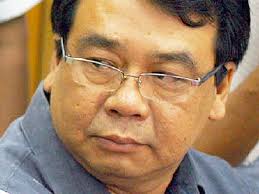
Bayan Muna Representative Neri Colmenares. INQUIRER file photo
The House minority is chary of the way “savings” has been defined in the proposed P3-trillion national budget for 2016, suspecting it of being “the second coming” of the outlawed Disbursement Acceleration Program (DAP).
In a press briefing, members of the Makabayan bloc raised questions about how the Department of Budget and Management (DBM) defined savings in the 2016 budget program, noting language that they said would allow the same practices under the DAP, which the Supreme Court ruled unconstitutional last year.
“The new definition of savings in the proposed 2016 budget is intended to skirt or avoid the Supreme Court’s decision on the DAP,” said Bayan Muna Rep. Neri Colmenares.
Stimulus program
The DAP was a so-called “stimulus” program that the Aquino government launched in 2011 to supposedly pump-prime the slowing economy. However, the high court struck it down in July 2014 for its unconstitutional practices, such as the cross-border transfer of funds, the declaration of savings before the end of the fiscal year and their realignment into items not found in the budget law.
Colmenares also alleged that the proposed 2016 budget was riddled with hidden pork barrel funds and discretionary lump sum appropriations that could be tapped by the Aquino government and its favored lawmakers.
‘Pork-free’
Budget Secretary Florencio Abad, who turned over the five-volume proposed expenditure program to the House of Representatives on Tuesday, said the budget was now “pork-free,” and that the definition of savings was the same as the one in the 2015 budget law.
Under the proposed 2016 budget, savings may be declared when there are balances of any programmed appropriations resulting from the following:
•“Discontinuance or abandonment of a program, activity or project by the head of agency concerned, for justifiable causes not attributable to the fault or negligence of the agency and which will render it impossible to implement the program;
•“Non-commencement or the inability of an agency to obligate an allotment for justifiable causes not attributable to the fault or negligence of the agency and which will render it impossible to implement that program in 2016”;
•“Improved systems and efficiencies in the implementation of the program and delivery of services which are consistent with their performance targets”;
•“A lower contract cost than that provided in the approved budget for the contract”; and
•“Unused personnel services costs pertaining to (1) unfilled, vacant or abolished positions; (2) non-entitlement to allowances and benefits; (3) leaves of absence without pay; and (4) the death of pensioners, decrease in the number of retirees, or other related causes”.
The proposed budget also defines “augmentation” as “the act of the constitutional officers authorized to use savings in their respective appropriations to cover a deficiency in any existing program within their respective offices.”
A deficiency in a project may result from unforeseen modifications or adjustments in the program, or reassessment in the use, prioritization and/or distribution of resources.
There are a number of differences between this definition and the one in the 2015 budget law.
For instance, in the 2015 budget, savings may be declared if there are balances resulting from the “final discontinuance or abandonment” of a program due to causes not attributable to a fault of the agency.
New definitions
The words “final” and “justifiable” are added in the new definition.
“Under the new definition, DBM did away with the requirement of finality, thus expanding the president’s discretion over public funds, vastly clipping the congressional power of the purse, and essentially legalizing DAP or post-enactment fund jiggling,” said Kabataan Rep. Terry Ridon.
“Congress should not make the same mistake twice,” he said.